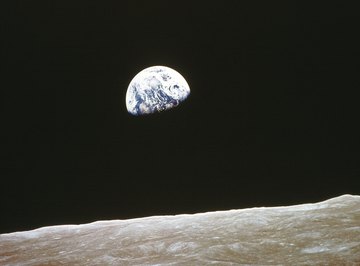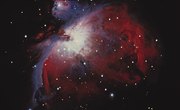
Ever since people have observed the night sky, they have tried to explain where the heavens came from. The age when the explanation was to be found in stories of gods and goddesses is in the past, and now the answers are sought through theory and measurement. One theory of how the moon was formed is that a planetesimal about the size of Mars hit the Earth and spun off a chunk of material that later became the moon. The lack of iron in the moon is one piece of evidence that supports the large-impact hypothesis.
Formation of the Solar System
The solar system was formed about 5 billion years ago, which means there is no way of observing it happen. Instead, scientists form different ideas -- hypotheses -- about how it might have happened, then make measurements that will either support or rebut the hypothesis. Although many details are still being debated, the general outline of the process is well understood. A large cloud of atoms -- mostly hydrogen atoms -- collapsed as they attracted each other with the force of gravity. When enough hydrogen atoms pressed tightly together in the center, the sun started creating fusion energy. The energy from the sun pushed the remaining atoms away from the center at the same time as gravity was pulling them toward the center. The balance of forces meant that heavier atoms tended to stay closer to the center while lighter atoms were pushed further out.
Formation of the Planets
At the same time as the sun was pushing and pulling the atoms, the atoms were pulling on each other, also. Neighboring atoms clumped together in little chunks, which clumped into bigger clumps and so on until they were more or less the planets you know today. The planets closest to the sun were formed from the heavier atoms in that vicinity, while the distant planets were formed mostly from lighter atoms. Within each planet, gravity was still at work, bringing the denser material into the center, leaving lighter material on the outside. On Earth, this meant that the heaviest elements, such as uranium and iron, descended to the core, while lighter molecules ended up farthest from the center.
The Large-Impact Hypothesis
In the early 1970s scientists proposed the large-impact or giant-impact hypothesis. The hypothesis states that a planetary body about the size of Mars struck a glancing blow on the Earth. The collision knocked loose chunks of the Earth's surface, and those chunks eventually attracted each other into the moon. The collision tilted the Earth, so the Earth rotates at an angle of 23.5 degrees relative to its orbit -- leading to seasonal variations on the Earth.
The Moon's Iron
When the planetesimal struck the Earth, the heavy elements -- such as iron -- had already settled deeper into the planet. So the collision broke chunks off the Earth, but these were chunks of the Earth's crust, full of lighter elements and molecules. The iron core of the planetesimal joined with the Earth's core, so only the lighter minerals and elements floated away. That explains not only the lack of iron in the moon but also why the moon is less dense than the Earth. That evidence, along with the spin of the Earth and a few other observations, has led most scientists to support the idea that moon is the result of a collision between the Earth and another planetary body.
References
About the Author
First published in 1998, Richard Gaughan has contributed to publications such as "Photonics Spectra," "The Scientist" and other magazines. He is the author of "Accidental Genius: The World's Greatest By-Chance Discoveries." Gaughan holds a Bachelor of Science in physics from the University of Chicago.
Photo Credits
Ablestock.com/AbleStock.com/Getty Images
